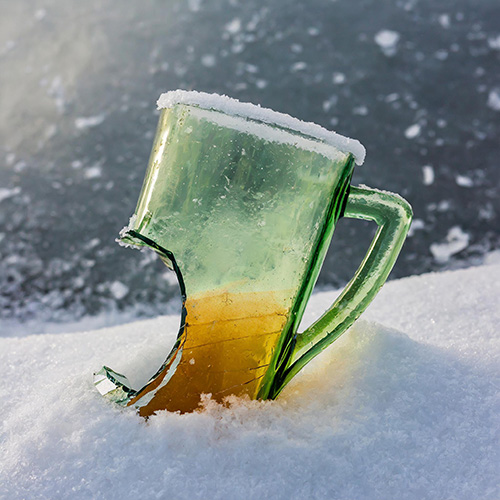 Watchdogging
Watchdogging  In the Doghouse
In the Doghouse  Damped If You Do: Big Alcohol Moves to Absorb Dry January
Damped If You Do: Big Alcohol Moves to Absorb Dry JanuaryDamped If You Do: Big Alcohol Moves to Absorb Dry January
 As January comes to an end, the most sophisticated minds in alcohol marketing have fallen back on the most basic strategy: name-calling. As Dry January, the cross-continental annual experiment with cutting out alcohol, comes to an end, so does the outsized coverage of “Damp January”. If the name seems unfamiliar, that could easily be because this was the year that it was pushed in force to stem industry losses to increasingly “sober curious” consumers.
As January comes to an end, the most sophisticated minds in alcohol marketing have fallen back on the most basic strategy: name-calling. As Dry January, the cross-continental annual experiment with cutting out alcohol, comes to an end, so does the outsized coverage of “Damp January”. If the name seems unfamiliar, that could easily be because this was the year that it was pushed in force to stem industry losses to increasingly “sober curious” consumers.
Though the phrase seems to have first appeared in print in January 2023, the Dry vs. Damp January difference was definitively staked out on January 8, 2024, by the New York Times. The paper wrote encouragingly about how “you can improve your health just by drinking less.” Experts were quoted. Various strategies were offered, including drink-tracking, changing social contexts, and alternating alcoholic and non-alcoholic drinks. In a vacuum, it seemed like a positive, encouraging article on healthier drinking habits, even if some otherwise sympathetic critics fully loathed the term.
But the reporting was not in vacuum. It was in the context of Dry January. The idea of starting the New Year sober originated with Alcohol Change UK, a charity dedicated to reducing alcohol harm. As original conceived, it was a formal campaign—participants took a pledge and stuck with it for a month, with the organization providing publicity and moral support. As it crossed the ocean, it became more informal, a pop-cultural experiment in self-care in which U.S. participants simply… did not drink. The result was an explosion of coverage of the health concerns of alcohol consumption in January, and perhaps associated developments such as the proliferation of alcohol-free nightlife and mocktail recipes.
As alcohol harm and industry profits both skyrocketed in the wake of the COVID-19 crisis, so did interest in reducing drinking—a possible backlash pattern in the face of an industry run amok. The industry in turn, responded in three ways: mocking and undermining it, profiting off it, and, with Damp January, conflating and assimilating it.
On the surface, Damp January—like nonalcoholic beers and mocktails—seems a laudable goal. Mindful consumption, the basic point of Damp January, is healthier than uncontrolled drinking, and, at least in concept, protective from binging and other dangerous behaviors. In fact, the tenets of Damp January should be the goal for anyone who drinks alcohol: stick to the planned number of drinks, don’t drink in ways that cause short- or long-term damage, and be aware of your own habits.
The problem—and the suspicion that the emergent concept was seeded by industry—comes from Damp January being the alternative to Dry January. Despite the parallel naming, the goals of the two Januarys are disaligned. The intention of Dry January, despite the way Damp January proponents frame it, is not to go to war with your instincts to drink. It is to pay attention to how you feel when cut out alcohol. The assumption is that the experience of going without alcohol will be self-encouraging.
Damp January, by contrast, turns the focus away from the self and one’s own happiness to the process of wrangling your own habits. It is presented in a way that directly challenges the self-efficacy in cutting alcohol out. Damp January is for those who cannot, whereas Dry January—particularly as an organized campaign, but also by creating informal support networks—centers on the message “You can.” And, most significantly, Damp January is directly promoted by the alcohol brands themselves, who stand to benefit from consumers opting to pursue it instead of its Dry cousin. Benefit more, certainly, than the consumers do.
That said, intentionality in alcohol consumption should be actively encouraged. It just should not be encouraged at the cost of experiments in non-drinking. A Mindful May, a Deliberative December, a Slow-Sipping September—there are 11 other months to appropriate that do not directly conflict with a growing movement to test the driest waters. In the meantime, hats off to those who just finished their 31 days, and congrats to those looking ahead to 2025.
READ MORE about industry backlash at Dry January
READ MORE about the paradox of the NA market
Help us hold Big Alcohol accountable for the harm its products cause.
| GET ACTION ALERTS AND eNEWS |
STAY CONNECTED    |
CONTACT US 24 Belvedere St. San Rafael, CA 94901 415-456-5692 |
SUPPORT US Terms of Service & Privacy Policy |

